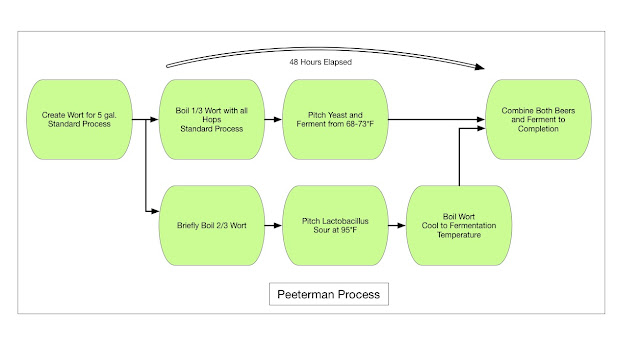I was scouring back though my
brewing books trying to get motivation for a recipe, something different. In Brewing
with Wheat, by Stan Hieronymus, I came across a recipe for a Peeterman, a
type of wheat beer. It was bigger, sometimes
darker and usually drunk fairly young.
It was similar to a Blanche de Louvain where “One third of the wort was
brewed with hops.”
In that same section Hieronymus
discusses how the beers from around Leuven (Louvain), Belgium were made. One third of the wort was boiled with hops
and the other two-thirds were ran straight into the fermenters. These beers were tart to sour and so I
thought, that this might be a perfect chance to make a modern take on this beer
through kettle souring a portion. I
wanted to make a beer that was sour, but not too sour, and that didn’t have the
chance to pick up any nasties.
My idea was that I would make
the wort, run off a third, and boil it with enough hops to contribute ~10 IBU
to the entire volume. The remaining
two-thirds I would run off into a separate kettle and sour. My idea of a modern take was to pre-boil the
two-thirds wort for a few minutes and then pitch a 3 GoodBelly shots (Lactobacillus
Plantarum) and let this sour for two days at 95*F. Back to the first third, I treated it just as
I would any of my beers, boiling it with the hops, cooling it to pitching
temperatures, and then pitching yeast. I
would let this beer ferment for 2 days while the other portion was souring, as
a kind of starter akin to the sake process, except on the second day I would
boil the soured wort for 15 minutes and pour it back into the fermenting
portion. Get all of that? It might take a flow chart…
My recipe looked like this:
Recipe: Peeterman
Style: Witbier
TYPE: All Grain
Date: 31 Mar 16
Batch Size (fermenter): 5.50
gal
Estimated OG: 1.065 SG
Estimated Color: 5.5 SRM
Estimated IBU: 10.5 IBUs
Brewhouse Efficiency: 70.00 %
Boil Time: 75 Minutes
Ingredients:
6.00 ml Lactic Acid (Mash 60.0 mins)
13.0 oz Rice Hulls (0.0 SRM) 4.9 %
7 lbs 1.4 oz Pilsner (2 Row) Bel (1.7 SRM) 42.8 %
7 lbs 1.4 oz Wheat, Raw (2.0 SRM) 42.8 %
15.1 oz Oats, Flaked (1.0 SRM) 5.7 %
7.6 oz Aromatic Malt (26.0 SRM) 2.9 %
2.5 oz Buckwheat, Raw (2.0 SRM) 1.0 %
16.00 g Crystal [6.00 %] - Boil 75.0 min 10.5 IBUs
0.50 tsp Yeast Nutrient (Boil 10.0 mins)
1.0 pkg Belgian Wheat Yeast (Wyeast Labs
#3942)
Mash Schedule: Single
Infusion, Batch Sparge
Mash In Add 21.92 qt of water at 163.6 F 150.0 F 60 min
Sparge: Batch sparge with 2
steps (Drain mash tun , 3.52gal) of 185.0 F water
Fermentation started at 68
degrees and finished at 73.
The execution of this recipe
was a disaster. Like anything for the
first time, I was running around trying to figure out what the hell I needed to
do next. I had also convinced myself
that I could do both batches at the same time.
This led to a couple of errors on brew day, not oxygenating the wort and
totally missing my numbers.
Missing the oxygen didn’t
turn out to be a big deal, but I had never used this much raw wheat in a batch,
and I totally missed my numbers. What
was supposed to be a big, sweet finishing beer, ended up at 1.043 preboil and
1.059 in the smaller one-third portion.
By calculation, I figured I would have somewhere around a 1.050 OG
beer. I chalked it up to a lesson, and
moved on.
From there the beer went on
great. The sour portion acidified down
to 3.5 pH by strip, which is a little better than measuring it with my
tongue. The yeast in the clean portion
ripped through the wort and was already slowing down when I combined the two
beers. It finished out nicely, albeit a
little higher, at 1.012, approximately 5.0% ABV, and 3.6 pH.
So even though this was
probably nothing like a Peeterman, it turned out a mighty fine beer. More so than other kettle soured beers that I
have tasted and made, this beer had a lot of character from the Saccharomyces
yeast. This was a nice welcome to a beer
that could have just been sour. The
finished beer had a good sour finish, but you could still catch that nice
Belgian character with a bit of bubble gum and stone fruit. I could not detect any major flaws, but as
the beer became warm there was an interesting phenolic note, that I don’t know
if I could describe. No one else who
tasted the beer was able to detect it.
If there was anything I would describe it as, it would be like a burnt
rubber or plastic, but very, very faint.
The lesson I’ve drawn from
this experience is one of blending, or you might call it portioning. It might be the best way to create a sour
beer. Aside from making a separate acid
beer and blending it with others, I think that splitting a beer like this makes
it a bit easier depending on your system, process, and space available. You don’t have as much control as you would
blending an acid beer, but you could be pretty exacting once you worked the
percentages out for your particular desires or recipe. I will definitely do this again in the future,
possibly leaving the sour portion un-boiled.
Maybe I’ll even do a cereal mash for all that raw wheat!

